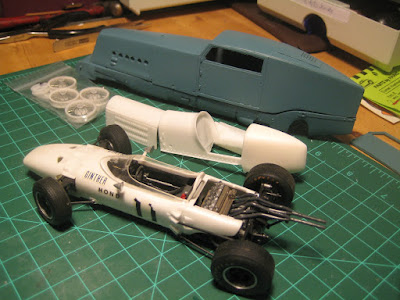This Indy car from the late 1920's was revolutionary in many ways. With a supercharged DOHC straight-8 of only 1.5 litres, it made substantially more power (200 hp, by some accounts) than the Edwardian Renault 40 Record with a 9-litre six (130 hp). It also had front wheel drive, the main reason being aerodynamics: it allowed the driver to crouch low behind the cowl and not have to sit up high, straddling a driveshaft. It also showed in 1927 that FWD was possible and easy. The picture shows the delicate little Miller with the slab-sided Renault 40, from Profil 24, and the Honda F1 with transverse 1.5 litre V12.

The major issue with this kit, as with most HRM kits, is the instruction sheet, which is terse to say the least. It consists of a page and a half of typed instructions which reads a bit as a stream-of-consciousness text; a parts list indexed to baggies numbered 1 to 9; and a couple of crude sketches for some of the less obvious parts. You are expected to find lots of detailed pictures online or in your personal library. Given I sold off all my books and magazines about 30 years ago, this all becomes part of the fun.

I chose the purple and yellow paint scheme of the #18 car driven by Leon Duray. The actual colours are of some debate, given the absence of period colour photos; the car presently resides in the Smithsonian and HRM's Harold Bradford feels the shade of purple used in the restoration should be lighter. So my use of Tamiya TS-24 is probably no less accurate than the Smithsonian's work.

The scheme certainly pops. Bradford says the frames were metal colour, but that the Smithsonian restoration crew painted the frame yellow.

Location of various bits is a matter of trial and error. Eventually I concluded that the front cross member is not actually a cross member but a sacrificial bit of resin intended to keep the chassis straight prior to building; cutting this out was the only way the transmission would fit between the frame rails.

The wheels are lovely with metal spokes that, according to the Smithsonian restoration, are painted yellow.
Some added details can be found in a lovely web site featuring thousands of line drawings (click here). Low resolution pictures are free but registration is required; highly recommended for scratch-building of obscure stuff. Real keeners will search out Griff Borgeson's definitive history of the Miller marque.
No comments:
Post a Comment